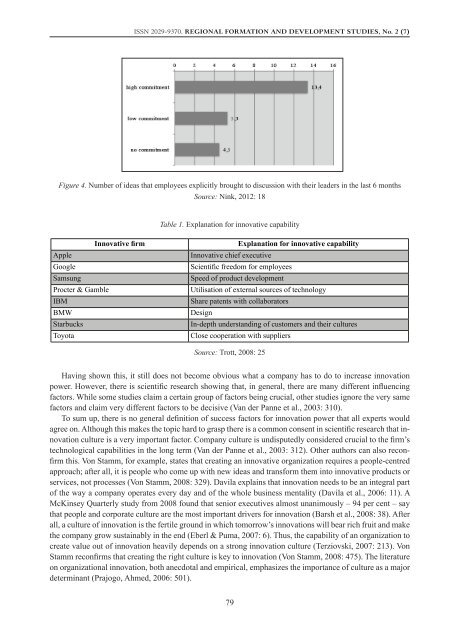regional formation and development studies - KlaipÄdos universitetas
regional formation and development studies - KlaipÄdos universitetas
regional formation and development studies - KlaipÄdos universitetas
Create successful ePaper yourself
Turn your PDF publications into a flip-book with our unique Google optimized e-Paper software.
ISSN 2029-9370. Regional Formation <strong>and</strong> Development Studies, No. 2 (7)<br />
Figure 4. Number of ideas that employees explicitly brought to discussion with their leaders in the last 6 months<br />
Source: Nink, 2012: 18<br />
Table 1. Explanation for innovative capability<br />
Innovative firm<br />
Apple<br />
Google<br />
Samsung<br />
Procter & Gamble<br />
IBM<br />
BMW<br />
Starbucks<br />
Toyota<br />
Explanation for innovative capability<br />
Innovative chief executive<br />
Scientific freedom for employees<br />
Speed of product <strong>development</strong><br />
Utilisation of external sources of technology<br />
Share patents with collaborators<br />
Design<br />
In-depth underst<strong>and</strong>ing of customers <strong>and</strong> their cultures<br />
Close cooperation with suppliers<br />
Source: Trott, 2008: 25<br />
Having shown this, it still does not become obvious what a company has to do to increase innovation<br />
power. However, there is scientific research showing that, in general, there are many different influencing<br />
factors. While some <strong>studies</strong> claim a certain group of factors being crucial, other <strong>studies</strong> ignore the very same<br />
factors <strong>and</strong> claim very different factors to be decisive (Van der Panne et al., 2003: 310).<br />
To sum up, there is no general definition of success factors for innovation power that all experts would<br />
agree on. Although this makes the topic hard to grasp there is a common consent in scientific research that innovation<br />
culture is a very important factor. Company culture is undisputedly considered crucial to the firm’s<br />
technological capabilities in the long term (Van der Panne et al., 2003: 312). Other authors can also reconfirm<br />
this. Von Stamm, for example, states that creating an innovative organization requires a people-centred<br />
approach; after all, it is people who come up with new ideas <strong>and</strong> transform them into innovative products or<br />
services, not processes (Von Stamm, 2008: 329). Davila explains that innovation needs to be an integral part<br />
of the way a company operates every day <strong>and</strong> of the whole business mentality (Davila et al., 2006: 11). A<br />
McKinsey Quarterly study from 2008 found that senior executives almost unanimously – 94 per cent – say<br />
that people <strong>and</strong> corporate culture are the most important drivers for innovation (Barsh et al., 2008: 38). After<br />
all, a culture of innovation is the fertile ground in which tomorrow’s innovations will bear rich fruit <strong>and</strong> make<br />
the company grow sustainably in the end (Eberl & Puma, 2007: 6). Thus, the capability of an organization to<br />
create value out of innovation heavily depends on a strong innovation culture (Terziovski, 2007: 213). Von<br />
Stamm reconfirms that creating the right culture is key to innovation (Von Stamm, 2008: 475). The literature<br />
on organizational innovation, both anecdotal <strong>and</strong> empirical, emphasizes the importance of culture as a major<br />
determinant (Prajogo, Ahmed, 2006: 501).<br />
79

















